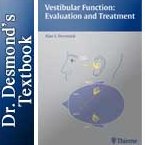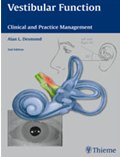Preventing Falls in the Elderly: Can It Be Done?
by Alan Desmond, Au.D.
Falls are the leading cause of injuries and injury deaths in the elderly population. Falls leading to hip fracture often result in premature institutionalization and deaths, as well as enormous health care costs. Approximately 40% of elderly American patients with hip fractures die within one year or are placed in long term care. Clearly, this is a staggering health care problem, which will increase dramatically as the elderly population increases. No one argues that we, as health care and medical professionals, should intervene. The questions are rather, “What to do?” and “Will it actually make a difference?”
Much attention has been paid to this subject in recent years, and systematic evaluation and intervention is on the rise in the United States. In fact, there is currently a bill before the US Congress titled the “Elder Falls Prevention Act of 2002” with the stated goal “to expand and intensify programs with respect to research and related activities concerning elderly falls.”
Poor balance and instability in the elderly has been described as a “geriatric syndrome”, because the specific cause of these complaints is often not obvious to the examiner. This is primarily because poor balance in the elderly is most often multi-factorial, with no single clinical abnormality responsible.
Tinetti et al (1994) studied a group of elderly (at least 70 years old) subjects with known risk factors for falling. By applying interventions aimed at specific risk factors, the intervention group had significantly fewer falls than the untreated control group. Specifically, subjects indentified with “balance impairment” had the greatest reduction in falls (over 50% fewer). Close et al (1999), followed a group of elderly (65 plus) patients that had presented to an emergency room after a fall injury. After medical and occupational therapy assessment, the intervention group received care for indentified risk factors for falling. At one year follow-up, the control group had more than twice as many falls than the intervention group.
Jacobson (2002) expanded on these findings by developing an assessment protocol to identify risk factors in patients that had fallen or had fear of falling.
RISK FACTORS
The following is a list of known factors for increased risk of falling:
- Vestibular Pathology – an impairment of the vestibular system can cause the patient to become dizzy or off balance associated with certain movements and certain visual environments.
- Polypharmacy – the use of four or more prescription medications or the initiation of a new medication or dosage have been associated with an increased risk of falling.
- Use of tricyclic anti-depressants or benzodiazepines are associated with increased risk of falls. SSRI antidepressants may have fewer side effects, but it is not clear that they result in a reduced risk of falling compared to tricyclics and benzodiazepines.
- Orthostatic (Postural) Hypotension – postural pre-syncope associated with orthostatic hypotension may result in an increased risk for falling when assuming the upright position.
- Impaired Proprioception (Somatosensation) – the sense of touch is an important contributor to balance and orientation. The stretch receptors in the legs, the finger tips, and the soles of the feet, all provide feedback for balance.
- Cerebellar Dysfunction – The integration of vestibular, visual and proprioceptive information takes place in the cerebellum. Cerebellar dysfunction can result in slow or inappropriate reaction to self movement or external visual stimuli.
- Hearing Loss – Hearing loss reduces one’s orientation and awareness of one’s surroundings. A person with hearing loss is more likely to be startled by movement in the visual field as they have fewer auditory warning signals.
- Impaired Vision – Vision plays an important role in balance and patients with visual deficits have greater risk for falls. Visual problems associated with decreased postural stability include: visual acuity less than 20/50, asymmetric vision impairing binocular vision and depth perception, slow pupillary reaction causing increased adaptation time when going from a lighted to a dark room and vice versa,and impaired peripheral vision.
- Depression – Depressed patients may be more internally (therefore less externally) aware. The use of antidepressants and anxiolytics increase the risk of falling.
- Impaired Cognition – Patients with impaired cognition may be less aware of their surroundings or more likely to engage is risky activities.
- Impaired Reaction Time – Many fall avoidance strategies are dependent on reaction time when postural stability is challenged. Slower reaction time may increase the risk of falls when the patient’s limits of stability are exceeded.
ASSESSMENT
Blue Ridge Hearing and Balance Clinic offers the regions only Fall Prevention Program. Our program is modeled after that used at Vanderbilt University Medical Center. We work with Physical Therapists in the region to provide a comprehensive assessment of known risk factors. A report is then forwarded to the referring physician with recommendations for intervention. Following a thorough history interview, the patient undergoes a series of tests of hearing and vestibular function (Audiogram, ENG, Rotary chair test and Posturography). Evaluation for orthostatic hypotension and a computerized review of medications and interactions is performed. Examination for strength, sensation and range of motion of the lower extremities is performed. Screening tests for depression and cognition are completed. The patient’s lifestyle, goals, and concerns are reviewed.
INTERVENTION
Typically, there is no magic bullet, or single intervention that will make a significant impact. Treating each identified risk factor has been shown (as noted above) to reduce the risk of falling. Treating a vestibular disorder may eliminate episodes of dizziness. Review of medications and possible side effects may prove helpful. Treating hearing loss or depression (often related complaints) may put the patient in better touch with their surroundings. Ongoing physical therapy and balance retraining can increase mobility and independence. Modifications to the home may reduce the number of fall hazards.
Please see the Fall Risk Questionnaire.



